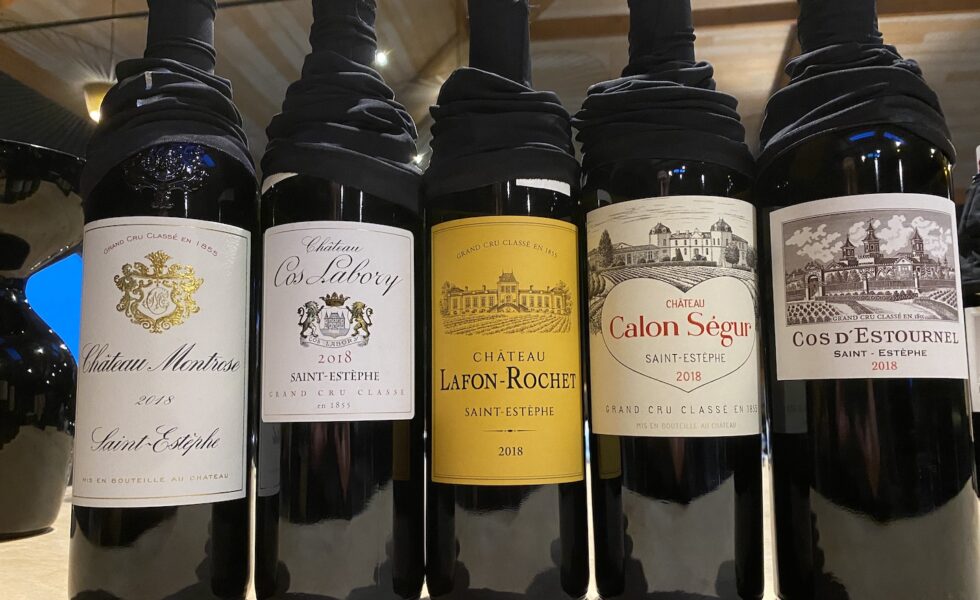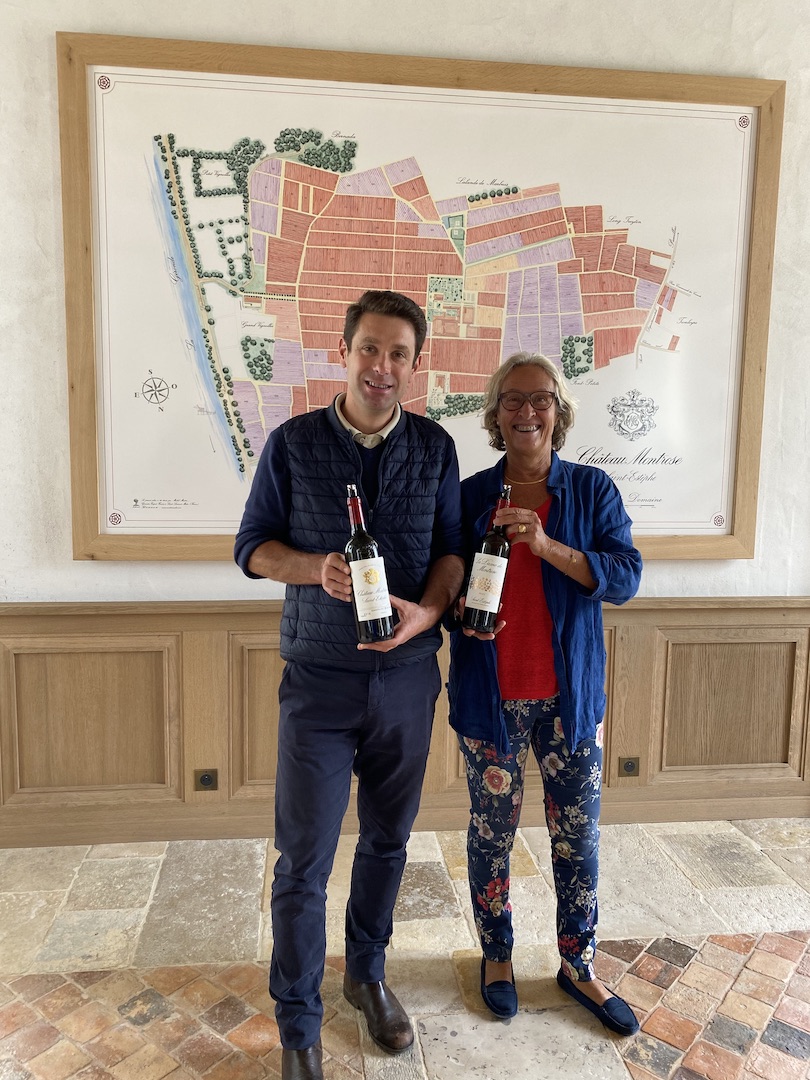Saint Estèphe 2018

By Panos Kakaviatos for wine-chronicles.com
24 January 2021
Fascinating to see – in a blind tasting of the five classified growths – just how impressive Château Montrose turned out to be. I have tasted the wine twice from bottle, once at the estate, once in the blind tasting (held at Château Lafon-Rochet), and although I still think that the 2016 will be better (or the 2019 for that matter, which I had tasted side-by-side), the 2018 Montrose impresses me most among the Saint Estèphes in 2018.
As usual, wines in bold I liked in particular. When red and bold, even more. And when underlined, wine nirvana 😊🍷😍.
Several wines tasted blind, others non blind.
Château Beau Site – Clearly nice this blend of 73% Cabernet Sauvignon, 25% Merlot and 2% Petit Verdot: At once very tasty and agreeable with density and power. Here an example of affordable fine 2018 Bordeaux – at about €20 a bottle in Europe. Tasted at Château Batailley with owner Philippe Casteja, who decided to leave the formal cru bourgeois system, but never mind this wine is still identified as such, and it is a very good wine indeed in 2018. 92
Château Calon Ségur – Tasted blind, this came across about as I had rather expected from barrel, with impressive “amplitude” and mid-palate density. The expressions of ripe dark fruit, spice and mint from the Cabernet Franc are pleasing. But there is a sense that the 100% new oak aging, combined with nearly 15% alcohol, leads to a drying finish in this blend of 65% Cabernet, 17% Merlot, 15% Cabernet Franc and 3% Petit Verdot. Such a high level of alcohol drew much oak derived tannin, and from a classified growth of this calibre, I am left perplexed. Maybe over time, the breed of the terroir will shine through. 2018 was the first vintage ever that the estate arrived at the same level of high alcohol for both Cabernet Sauvignon and Merlot and that is quite astounding. Now the pH at 3.75 is not the highest encountered in this vintage, and just enough acidity balances things, but I would rather go for the 2016 to be sure. Conservative score from yours truly. 93
Château Cos d’Estournel – In a blind tasting, the wine under-performed, so I went to the château to be sure, and lo and behold, a wonderful wine, as I had experienced from barrel. A bit tight today, the high tannin and acidity noticeable but underlying power and class denoted by distinct red fruit. “Time will bring that 3rddimension”, remarked technical director Dominique Arangoïts. “We saw how hot and dry it was getting and chose to keep leaves on the vines,” he explained. In terms of winemaking, fermented at lower temperatures to preserve freshness: at 27° rather than 30°C. At 14.6% alcohol, a bit lower alcohol than the Montrose, for example. And it comes across more classical in style by comparison for the vintage, with more freshness, via a pH of 3.69. It contains more Merlot in the blend this year, at 23% and Cabernet Sauvignon at 74%. The high tannic index, at 80, warranted less new oak for aging, at 50% new oak rather than 60%. But in battle between the two “second growths”, at this early stage from bottle, I nod to Montrose. 95

Cos d’Estournel technical director Dominique Arangoïts at the estate.
Château Cos Labory – Tasted blind and I liked it! Sure, it came across the most austere and least approachable (among the classified growths), yet you have power and tannic weight, which show much promise for cellaring. I would not open for at least about five years. 93+
Château Le Crock – Healthy deep purple hue, with aromas of blackberry and plum, this blend of 57% Cabernet Sauvignon, 33% Merlot, and 5% each of Petit Verdot and Cabernet Franc comes across rich and savory. It has some imposing tannin but over a three-day period, the wine really proved delicious, so this is an excellent example of Saint Estèphe excellent in a hot vintage. 92

Fine deep purple, and an affordable quality Le Crock.
Dame de Montrose – Although initially a bit austere, with noticeable tannin, time in glass reveals mid-palate succulence and juiciness that appeal. This second wine of Château Montrose clocks in at 3.7 pH and has 14.8% alcohol. This is actually not the monster I was expecting, and better than the Carruades de Lafite, in tems of high end second wines. It comes across suave and supple, but the “scale” is there, and some precision, too. There is a sense of alcohol that is undeniable. Going back to the nose and you get more of a rustic aspect on the tannins (after tasting the grand vin). You sense the alcohol more here than you do on the grand vin. But this is still pretty darn tasty. 92+
Château Lafon-Rochet – From the start, vivid dark fruit juiciness and ripeness but with a fine frame of suave and very present tannin (this is a baby). I love the “amplitude”, the palate density, too. It has already softened since the barrel tasting, and it comes across rather approachable and refined. The quality is excellent and well worth the $50 tax included price tag in the U.S. 94+

For about $20 / €20, you get an excellent Saint Estèphe. And special mention to its even less expensive second wine, in 2018.
Château Lilian Ladouys – Similar experience to positive impressions when tasted along with other Cru Bourgeois wines. This is quite tasty, with a rich, opulent nose of strawberry and plum fruit, la baie du mur, with smooth and juicy texture. As experienced from barrel, a tannic edge that reflects the image of Saint Estèphe and that is a good sign, leading to a juicy finish. 93
Château Montrose – What mouthful of wine, opulent and with superb balance. Set along with the other classified growths, in a blind tasting in November of 2020, the Montrose won handily. But it is interesting to note how it compares to an experience I had back in the summer of 2020, when compared to the Montrose 2019 from barrel, and how I preferred the 2019… Does the plot thicken? Read on! The in-bottle label will indicate 14.5 but in fact the level is 14.8% with a pH of 3.7. Only 53% of the harvest, which lasted some two weeks, made it into the first wine. At the estate non-blind, I got a fine sense of balance, indeed, but will it have the same energy as in 2016, which has 13.2% alcohol and 3.6 pH? Still, the wine has an enveloping palate and downright silky tannins. “We had to pick quickly, to get fair (enough) degrees,” remarked director Vincent Decup. “The grapes were so very small and yet so very rich, we had to be careful about extraction and this stopped pumping over the must after a certain time; yes, we had to limit extractions so as to avoid too much massive tannins.” Furthermore, the macerations were a bit cooler.

Vincent Decup and Hélène Brochet of Château Montrose in the summer of 2020.
For Decup, 2018 is comparable to 2010. Tasted at the estate last summer, the 2018 is exuberant, strong, large and long, while the 2019 is more classic, albeit with certain flamboyance, too. Alcohol is lower than last year, at 14.45% as opposed to 14.8%, although the pH at 3.7 is about the same as 2018. But the impression in 2019 is more floral, slightly cooler fruit, even somewhat crunchy fruit, and, dare I say, a bit more serious. Indeed, the cooler evenings of August lent more energy and vivacity to this vintage. I also found the oak integration to be superior and, at this (very early) stage, I prefer the 2019. But let us give the 2018 the highest score among the wines of Saint Estèphe, as it is impressive! 96+
Pagodes de Cos – Tasted blind, it was my favorite among the second wines from the classified growths. The nose from this second wine of the great Cos d’Estournel is not very expressive but with time in glass, you get small wild berry aromas, a hint of floral and even a touch of green pepper, which I like here. “We kept some leaves over the grapes, to be sure that it would not be overripe,” remarked technical director Dominique. Even if you sense some alcohol on the finish (that’s the 2018 character in some cases), mid palate succulence with polish and refinement is appealing in this blend if 54% Cabernet Sauvignon, 37% Merlot, 6% Petit Verdot and 3% Cabernet Franc, clocking in at 14.5% alcohol. 93
Château Tronquoy Lalande – A frank success from bottle, this wine clocking in at 14.7% alcohol, but with moderate 3.65 pH. The blend of 51% Merlot, 44% Cabernet Sauvignon, 3% Petit Verdot and 2% Cabernet Franc features rich and scrumptious aromas. The palate conveys Black Forest Cake decadence albeit with a touch of warmth on the finish, as expected from 2018 sometimes. 93
 Wine Chronicles
Wine Chronicles
Share This